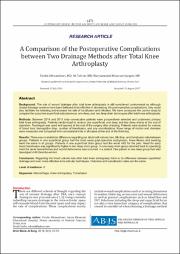A Comparison of the Postoperative Complications between Two Drainage Methods after Total Knee Arthroplasty
(ندگان)پدیدآور
Mirzatolooei, FardinTabrizi, AliMokaram Gargari, Maryamsadatنوع مدرک
TextRESEARCH PAPER
زبان مدرک
Englishچکیده
Background: The role of wound drainage after total knee arthroplasty is still considered controversial as althoughclosed drainage systems have been believed to be effective in decreasing the post-operative complications, they couldalso facilitate the bleeding and increase the rate of transfusion and infection. We have conducted the current study tocompare the outcomes superficial subcutaneous, one deep, and two deep drain techniques after total knee arthroplasty.Methods: Between 2014 and 2015 sixty consecutive patients were prospectively selected and underwent primarytotal knee arthroplasty. Patients randomized to receive one superficial, one deep and two deep drains at the end ofoperation. Tourniquet was used and opened at the end of the surgery after dressing. Patients were studied for volumeof blood loss, hemoglobin drop, number of transfusion, and any complications. Knee range of motion and diameterwere measured and compared with contralateral side in all cases at the end of the third day.Results: There was no statistical difference regarding red blood cell volume loss, Hb drop, and transfusion rate betweengroups. Patients in one superficial group had the most sever post-operative ecchymosis. Knee flexion and swellingwere the same in all groups. Patients in one superficial drain group had the worst VAS for the pain. Need for earlyblood transfusion was significantly higher in two deep drain group. In one deep drain group returned back to operatingroom for sever hemarthrosis and wound dehiscence was occurred in a patient. One patient in one deep group had alsodeveloped mild thrombo-emboli.Conclusion: Regarding the blood volume loss after total knee arthroplasty there is no difference betweensuperficial drainage and even more effective intra-articular techniques. Outcome and complication rates are thesame.
کلید واژگان
HemorrhageKnee arthroplasty
Transfusion
Knee
شماره نشریه
1تاریخ نشر
2018-01-011396-10-11
ناشر
Mashhad University of Medical Sciences, Iranian Society of Knee Surgery, Arthroscopy and Sports Tramatology,Iranian Orthopaedic Associationسازمان پدید آورنده
Urmia university of Medical Sciences, Urmia, IranUrmia university of Medical Sciences, Urmia, Iran
Urmia university of Medical Sciences, Urmia, Iran
شاپا
2345-46442345-461X





